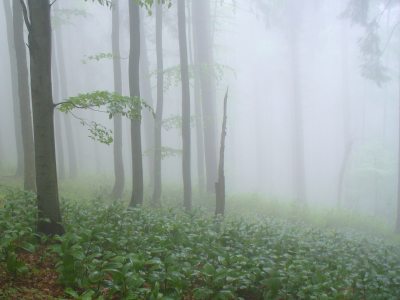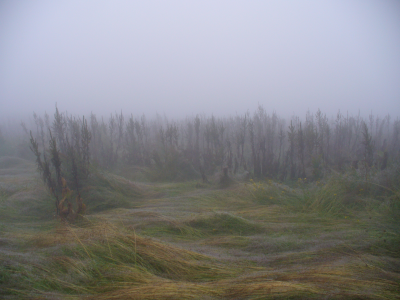 2006
2006
 2008
2008
 2010
2010
 2012
2012
 2014
2014



 |
„White Hellebore – many faces of the rarity of Polish mountains”
The diversity of chosen Veratrum lobelianum Bernh. populations in an altitude gradient and different habitat conditions
Jadwiga Bosek – author of photographs and project manager Looking for the 13 answer in the mist – Veratrum lobelianum on Muńcuł, 2011 Looking for the answer in the mist – fruiting shoots on Czantoria, 2011 |

|
Description popularizing the research project
A worryingly useful plant grows in the forests of Beskidy. It is a true botanical lie detector – Veratrum, known also as false hellebore. Old herbalists knew its properties well. Powder made of its rhizomes made an honest person sneeze, which in times long ago confirmed the person’s words were truthful. Liars were believed to be resistant to it. The mysterious hell born plant apart from sneezing causes also severe lacrimation, salivation, violent vomiting, staggering, blindness, dizziness and even worse symptoms described vividly in professional literature at the beginning of 19th century. It is easy to imagine that in case of overdosing it; the death came after a withering agony. It should be no surprise as the sap of the plant, like notorious South American curare, is said to have been used by Celtic warriors to poison their arrows. Sheep and cows give it a wide berth, as they are also sensitive to the alkaloids produced by hellebore. Nowadays phytopharmacologists confirm the dangerous properties of hellebore. They use it in curing certain illnesses and parasite infections with great care as the difference between the curing dose and the lethal one is dangerously narrow. Yet wanderers crossing mountain paths in Beskidy need not worry. The plant is hard to find, as it is a rarity with perfect camouflage. While in the open it is an impressive plant growing up to 1.5 meter, in forests it lurks among other plants reaching modest 30 centimeters. Yet this ability to hide does not protect it completely. That is why both the plant itself and its habitats are strictly protected. In the past, the concoctions made of hellebore were the ‘ultimate medicine’ used as the last resort when all other options failed. Today it has become an object of studies by pharmacologists, botanists, geobotanists and geneticists trying to discover the secrets of its changing faces and interesting reproduction strategies. All of these to make sure that in the future hellebore itself does not require some ‘ultimate medicine’, if all other methods of protection fail.
Abstract
During the realisation of the project “The diversity of chosen Veratrum lobelianum Bernh. populations in an altitude gradient and different habitat conditions” detailed investigations of nine Veratrum lobelianum populations are being carried out. It is a rare, mountain species that also occurs in lowland. In the mountains, it is a component of many forest and non-forest plant communities, whereas in lowland it grows mostly in forest phytocoenoses. Depending on the type of plant community in which this species appears, its shoots show interesting morphological variability. This plant may multiply vegetatively. Six mountain populations from the area of the Western Beskidy (three forest and three non-forest populations) and three forest populations from the area of adjacent lowland (the Silesian Upland) are being analyzed. Genetic diversity (AFLP technique), morphological variability and habitat conditions (soil features and phytocoenological characterisation) are examined in every population. The main aim of the project is to find out if the differences in phenotype and genetic diversity of chosen V. lobelianum populations are higher between the group of mountain populations and the group of lowland populations than between the populations within the groups. The second goal is to examine if there are noticeable differences between the group of forest and non-forest mountain populations caused by the habitat dissimilarities. An additional aim is to answer the question if the level of phenotype variability of chosen populations is related to the similar level of genetic diversity. There will be undertaken a trial of correlation of all the obtained results (biometrical measures, genetic analyses, habitat data). Acquiring information about the genetic diversity of populations of rare plant species, such as V. lobelianum, will enrich knowledge of the biodiversity of Poland and Central Europe. It will also enable its better conservation. Research on the genetic, morphological and habitat variety of populations of mountain species occurring also in lowlands will contribute to extending knowledge of ecology and biogeography. Furthermore, the data on the genetic diversity of species that exist in different habitats and at different altitudes may be helpful for better protection of their localities.
Patronat honorowy
Leszek Jodliński
Dyrektor Muzeum Śląskiego w Katowicach
Zygmunt Łukaszczyk
Wojewoda Śląski
Jan Malicki
Biblioteka Śląska
Piotr Uszok
Prezydent Katowic
Adam Matusiewicz
Marszałek Województwa Śląskiego















